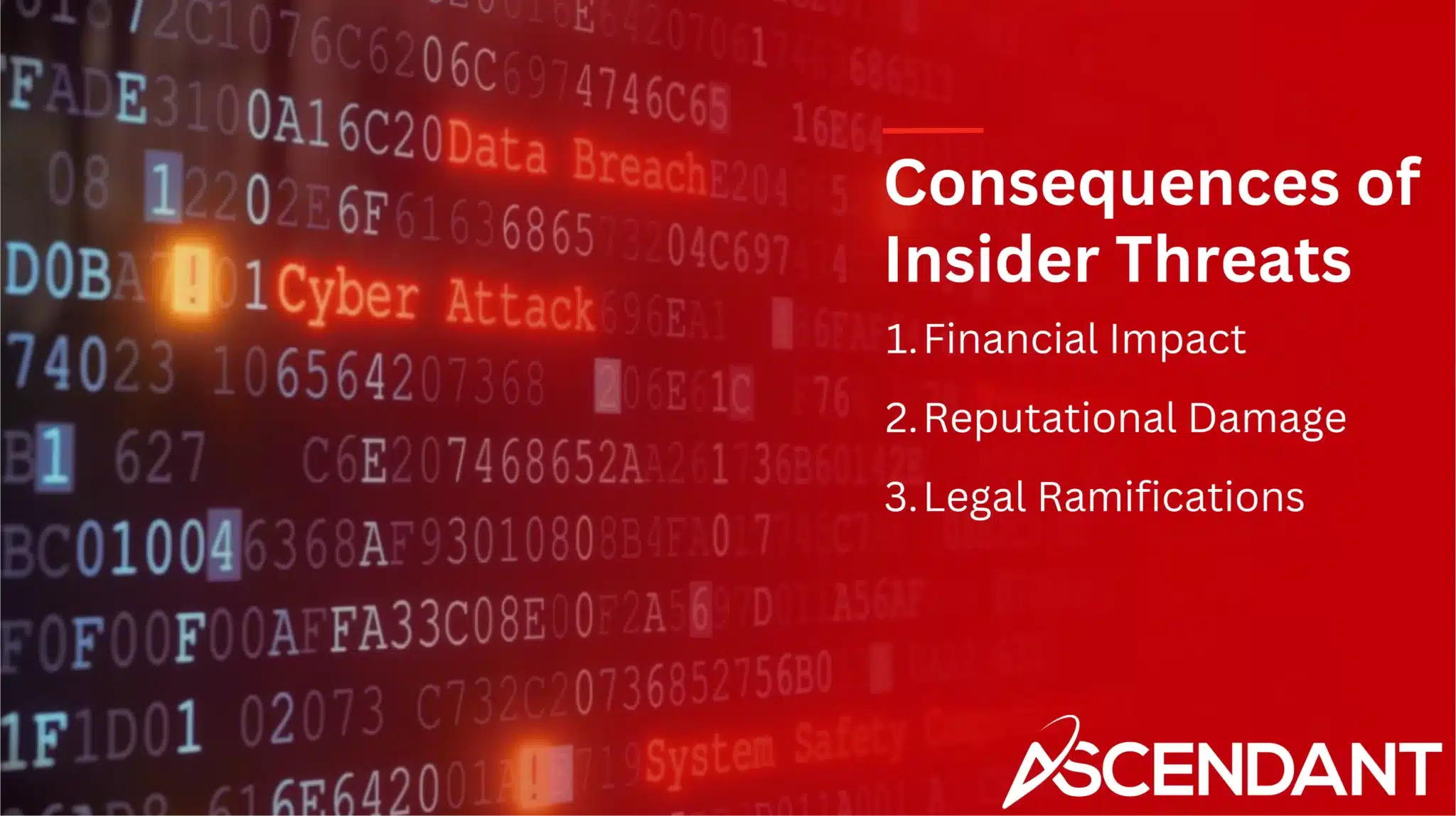Insider threats involve risks from employees or contractors misusing their access to your organization’s resources. These threats can be intentional or accidental; however, both pose significant risks to data security and operations. In this article, we’ll discuss the types of insider threats, ways to detect them, and best practices for prevention.
In This Article:
- Defining Insider Threats
- Categories of Insider Threats
- Identifying Insider Threat Indicators
- Real-World Examples of Insider Threats
- Consequences of Insider Threats
- Best Practices for Preventing Insider Threats
- Developing an Insider Threat Program
Key Takeaways
- Insider threats encompass risks from authorized individuals, including employees and contractors, and can result in significant operational and financial disruptions.
- There are three primary categories of insider threats: malicious, unintentional, and third-party, each requiring tailored detection and prevention strategies.
- Implementing a comprehensive insider threat program that includes clear policies, continuous training, and advanced technology solutions is essential for effective risk management.
Defining Insider Threats
Insider threats constitute hazards stemming from people who have authorized access to an organization’s assets, such as employees and contractors. They may leverage their legitimate access for improper purposes, circumventing standard security protocols and thereby complicating the detection process which could result in insider attacks.
Such internal risks can precipitate data theft, monetary deception, disruptions in operations, and legal complications. Therefore, being alert in detecting insider threats is imperative for safeguarding assets and adhering to regulatory requirements that mandate the capacity to detect insider threats.
These intrinsic dangers possess the potential to gravely compromise an organization’s functional stability and its overarching objectives.
Categories of Insider Threats
Insider threats can be classified into three distinct types: malicious insider threats, inadvertent insiders, and third-party risks. To successfully manage these dangers, it is essential to recognize the differences among them and implement tailored strategies for their detection and prevention.
Malicious insider threats are intentional actions taken by individuals within an organization with the objective of personal enrichment or retribution. They deliberately exploit access to sensitive assets. Conversely, unintended data breaches stem from human error or carelessness on behalf of employees—this type constitutes unintentional insider threats.
The final category encompasses third-party insider perils that occur when external entities like contractors or business partners who possess authorized entry cause security vulnerabilities due to either negligent practices or deliberate harmful intent.
Malicious Insider Threats
Malicious insider threats involve intentional harm for personal gain or revenge, often driven by grievances like feeling undervalued or seeking financial reward. Common forms include data breaches and operational sabotage, where insiders misuse their access to steal or destroy information.
Malicious insiders are often familiar with enterprise systems, giving them an advantage over external attackers. This familiarity allows them to exploit vulnerabilities more effectively, often leaving identifiable signs like dissatisfaction or excessive task engagement.
Unintentional Insider Threats
Employee mistakes or oversight, including the accidental sharing of sensitive data or emails sent to the wrong recipient, can unintentionally become insider threats. Even in the absence of malicious intent, these frequent slips can culminate in serious data breaches.
When employees neglect adherence to established procedures, considerable leaks of information may ensue. Insiders who overlook security policies inadvertently increase vulnerability to potential threats, potentially resulting in severe penalties, harm to reputation and extensive loss of data.
Third-Party Insider Threats
Insider threats stemming from third-party entities, such as contractors or business partners, present a considerable risk when these individuals exploit their authorized entry points to access confidential data or systems. These security vulnerabilities can emerge through either inadvertent mistakes or deliberate intent to harm. The scenario becomes especially worrisome with collusive insider threats where there’s a conspiracy between internal and external parties.
When vendors or contractors have the capacity to reach into an organization’s sensitive environments, they bring about substantial danger that may lead to compromised security protocols. Insiders might divulge proprietary information deliberately or be pressured into sharing it with outsiders, thereby broadening the spectrum of potential risks. This collaborative approach among insiders poses serious challenges by introducing weak spots in an enterprise’s protective measures against attacks.
Identifying Insider Threat Indicators
Identifying a range of indicators is key to the early detection and prevention of insider threats. It is critical to be vigilant for any deviations from standard user behavior, which may arise due to deliberate activities or accidental oversights. In this context, recognizing both behavioral and technical indicators plays an important role.
Observing patterns in user logins as well as network interactions can expose atypical access efforts that could indicate the presence of an insider threat. Intrusion detection systems examine network traffic while monitoring tools scrutinize user conduct with the aim of pinpointing potential dangers. To successfully detect these anomalies, it’s imperative to establish what constitutes normal activity for users and devices.
Behavioral Indicators
Observing behavioral cues is essential in pinpointing possible insider threats. Signs such as escalating disputes with coworkers or a sudden decline in work performance and involvement may point to potential risks.
By tracking these shifts in conduct, organizations can identify insider threats at an early stage. Vigilance over employee contentment and other behavioral signs enables firms to supervise insider actions and tackle potential dangers proactively before they intensify.
Technical Indicators
Crucial to the detection of insider threats are technical indicators. When data download activity surges significantly above normal baselines, it may suggest malevolent intent. Analyzing abnormal patterns through user and entity behavior analytics can hint at looming threats.
For recognizing insider threats, intrusion detection systems play a vital role by monitoring network traffic and analyzing user actions. Utilizing these technical markers is instrumental in enabling organizations to protect their systems from potential dangers effectively.
Real-World Examples of Insider Threats
Actual incidents illustrate the significant consequences that insider threats pose to organizations. Scenarios such as intentional data sabotage by unhappy workers, unintentional sharing of sensitive information, and partnerships with outsiders emphasize the critical need for measures against these dangers.
Investigating each incident provides a deeper understanding of various forms of insider threats along with their potential repercussions. By analyzing these events, companies can gain knowledge from previous occurrences and introduce strategies to prevent them.
Data Deletion by Disgruntled Employees
A furloughed individual, who had previously worked at Stradis Healthcare, infiltrated the company’s network in March 2020. This former employee proceeded to eliminate critical shipping information, thereby disrupting crucial deliveries of personal protective equipment (PPE). In a similar vein, Juliana Barile—whether still employed or not—erased upwards of 21 gigabytes worth of sensitive data following her termination.
These events underscore the profound risks associated with dissatisfied employees wielding access permissions. The potential for substantial interruption to operations and significant economic damage underscores the urgent need to rigorously control access to sensitive information.
Accidental Data Exposure
In 2022, sensitive systems within Microsoft’s GitHub infrastructure were at risk of unauthorized access when an employee inadvertently revealed login details. This situation underscores the danger that human error poses and emphasizes the importance of implementing stringent security measures.
Exposing data accidentally creates a substantial threat to security by potentially opening up access to confidential information and increasing the likelihood of data breaches. It is imperative that rigorous security procedures are established and employees receive thorough training to reduce these vulnerabilities.
Collaboration with External Entities
Insider threats that are collusive in nature include internal personnel collaborating with outside parties to compromise security systems. For instance, accusations have been leveled at ex-employees of Apple for allegedly pilfering sensitive data to advantage a rival startup. Such partnerships take advantage of weaknesses within organizations to commit data theft, underscoring the imperative for strong security protocols to protect confidential information.
Consequences of Insider Threats
Grasping the significant repercussions of insider threats is essential for crafting robust strategies to prevent and mitigate them. These consequences, which span financial stability, reputational damage, and legal issues, underscore the importance of prioritizing management efforts against such internal risks.
Financial Impact
In 2023, organizations faced an average annual expense of $16.2 million in addressing insider risks, with the most significant costs stemming from containment and remediation efforts. These expenses are related to incidents involving insiders who cause data breaches leading to immense financial losses that include legal repercussions and penalties.
The economic impact of insider threats is considerable due to hefty investigation and remediation expenditures which can accumulate into millions. This represents a formidable challenge for any organization aiming at financial gain prevention, underscoring the need for strong preventive strategies against such internal security breaches.
Reputational Damage
An organization may suffer serious harm to its reputation due to a security breach originating from an insider, leading to diminished trust among customers and a subsequent decline in sales. This erosion of confidence can cause customer churn and enduring damage to the brand.
The presence of insider threats poses a risk that can inflict lasting damage on companies, undermining customer trust and loyalty. These occurrences highlight the critical importance of implementing proactive measures for threat management.
Legal Ramifications
The consequences of insider threats can encompass substantial repercussions under data protection statutes and regulatory frameworks, leading to hefty fines for non-compliance. The financial burden from such threats is exacerbated by the costs associated with legal representation and rectification efforts.
The harm to reputation resulting from insider threats may erode consumer confidence and diminish prospects for future business dealings, thereby affecting the organization’s stability as a whole. Recognizing these potential legal outcomes is essential in adhering to compliance standards and reducing risk exposure.
Best Practices for Preventing Insider Threats
To effectively manage risks and prevent insider threats, an organization must adopt a diverse strategy that includes the establishment of explicit security policies, ongoing employee training programs, and the integration of cutting-edge technological tools. All these components are critical for a complete insider threat prevention framework.
It is crucial to take proactive steps in order to protect organizational assets and maintain smooth operations. This involves implementing robust measures against potential internal security breaches.
Implementing Security Policies
Establishing and distributing well-defined security policies is a critical step in protecting against threats from within the organization. It’s imperative to clearly articulate these policies to employees, outlining their duties, and ensure they are kept current through frequent revisions.
To promptly identify any insider threats and confirm adherence to security policies, continuous observation of employee behavior is necessary. Such surveillance must be carried out with respect for individual privacy rights and in accordance with legal regulations.
Employee Training and Awareness
Ongoing education equips staff with the skills to detect and counteract potential insider threats. Keeping them informed through consistent training sessions ensures they are abreast of new security measures and evolving threats, thus nurturing an environment where awareness of security is a priority.
Encouraging an atmosphere where security consciousness is ingrained considerably diminishes the likelihood of insider threats. When employees are thoroughly knowledgeable, they have a heightened capability to spot and neutralize potential risks, which in turn strengthens the organization’s collective security defenses.
Leveraging Technology Solutions
Cutting-edge technology plays a pivotal role in real-time monitoring and analysis required to detect and mitigate insider threats. Solutions such as Proofpoint Insider Threat Management provide instantaneous visibility into user behaviors, which helps organizations pinpoint risks at the moment they occur, especially for insider threat detection.
By implementing user and entity behavior analytics (UEBA), companies can automatically identify abnormal activities of employees by scrutinizing data flows and highlighting critical alerts for prompt action. Security Information and Event Management (SIEM) systems gather extensive data that enhances the examination of insider conduct, proving essential in protecting against such dangers.
Developing an Insider Threat Program
It is essential to establish a wide-ranging program for the management of insider threats due to their enduring nature, necessitating relentless vigilance. For detecting and handling instances of insider abuse effectively, a detailed security strategy must be adopted that enlists cooperation from various divisions to IT.
Adopting an all-encompassing strategy for managing insider threat programs is imperative, which includes conducting risk assessments, devising plans for incident response, and implementing ongoing surveillance measures. Such comprehensive preparation fortifies the organization’s safeguards against potential threats originating from within.
Risk Assessment
Undertaking a risk evaluation is imperative for organizations to recognize the vulnerability of their critical assets in relation to insider threats. Scrutinizing user activity and permissions regarding sensitive data assists in detecting possible threats proactively.
It’s essential for organizations to conduct frequent reviews to verify adherence with established security policies. These evaluations help prioritize risks according to their potential severity, enabling an organization to concentrate on mitigating the most perilous insider threats and safeguarding its key resources effectively.
Incident Response Plan
Having a well-defined incident response strategy is essential for the prompt identification and alleviation of insider threat occurrences. Such a plan needs to include various stages: preparation, detection, analysis, containment, eradication, recovery as well as a review following an incident.
It’s vital that the plan details precise steps to follow once an insider threat emerges. This should clarify responsibilities, establish communication guidelines and set forth unambiguous methods for confronting threats effectively. By doing so, it facilitates a rapid and systematic reaction which serves to curtail the ramifications associated with incidents caused by internal threats.
Continuous Monitoring
It is essential to maintain constant vigilance for the timely identification of insider threats. By adopting real-time monitoring systems, organizations can spot unusual patterns of behavior that could signal an impending insider threat and take immediate action to prevent it.
By keeping a continuous watch on user activity, companies are better positioned to uncover early signs of potential insider threats. Taking quick measures in response to these indications is vital for upholding strong security measures against such internal risks.
Summary
In essence, insider threats represent a considerable hazard to enterprises due to deliberate malevolent activities, accidental mistakes, and cooperative endeavors with third parties. To detect and counter these dangers effectively, an all-encompassing strategy is vital that incorporates assessment of behavioral patterns and technical indicators as well as examination of real-life incidents alongside recognition of the repercussions resulting from actions taken by insiders.
Organizations can proactively thwart and handle insider risks through the adoption of security policies reinforced by ongoing staff education together with cutting-edge technological solutions. Establishing a strong program aimed at addressing insider threats—which includes evaluating potential risks, crafting plans for responding to incidents promptly when they occur, along with persistent oversight—is critical in protecting organizational resources while assuring enduring safety and security.
 Frequently Asked Questions
Frequently Asked Questions
What are insider threats?
Insider threats are risks presented by individuals who have authorized access to an organization’s resources, such as employees and contractors. They can result in significant issues, including data theft and operational disruption.
What are the main categories of insider threats?
Understanding the primary classifications of insider threats is essential for an organization to manage and reduce potential risks effectively. These categories include malicious insider threats, unintentional insider threats, and third-party insider threats.
How can organizations detect insider threats?
Organizations can effectively detect insider threats by closely monitoring behavioral indicators like unusual login patterns and data download spikes, as well as employing tools such as intrusion detection systems and user behavior analytics.
Taking these proactive measures is crucial for safeguarding sensitive information.
What are the consequences of insider threats?
Insider threats can lead to severe financial losses, reputational damage, and potential legal liabilities due to data breaches and operational disruptions. These repercussions highlight the importance of implementing effective insider threat management strategies.
What are some best practices for preventing insider threats?
It is crucial for the establishment of explicit security policies, the provision of continual training to employees, and the deployment of sophisticated technological solutions in order to mitigate insider threats effectively.
It is vital to put into place an exhaustive program tailored towards insider threats which encompasses risk evaluation, devising plans for incident response, and perpetual surveillance.



